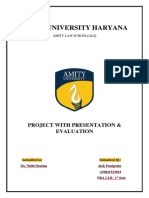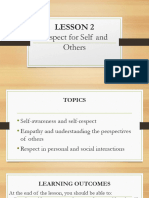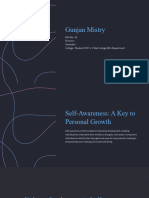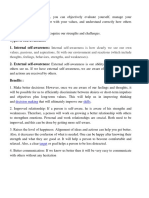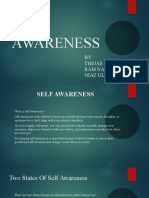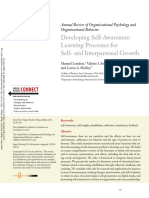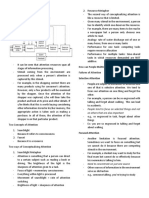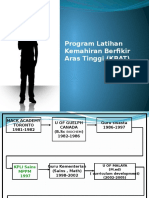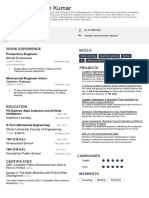Lecture Notes: Understanding Self-Awareness
I. Introduction to Self-Awareness
Definition: Self-awareness is the ability to introspectively recognize and understand
one's own thoughts, emotions, motivations, and behaviors.
Importance:
o Enhances personal growth and development.
o Improves decision-making and problem-solving skills.
o Facilitates better interpersonal relationships.
o Key to emotional intelligence.
II. Types of Self-Awareness
1. Internal Self-Awareness:
o Understanding one's own values, passions, aspirations, and impact on others.
o Recognizing strengths, weaknesses, and areas for improvement.
2. External Self-Awareness:
o Understanding how others perceive oneself.
o Receiving and processing feedback effectively.
o Balancing internal perceptions with external realities.
III. The Components of Self-Awareness
1. Emotional Awareness:
o Identifying and understanding one's own emotions.
o Recognizing triggers and patterns in emotional responses.
2. Self-Perception:
o Understanding one's strengths, weaknesses, and areas for growth.
o Forming a realistic self-concept.
3. Behavioral Awareness:
o Recognizing how actions and behaviors impact oneself and others.
o Being mindful of non-verbal cues and body language.
IV. Developing Self-Awareness
1. Reflection:
o Engaging in introspection and self-examination.
o Journaling or keeping a reflective diary.
2. Seeking Feedback:
o Actively seeking and accepting constructive criticism.
o Being open to different perspectives.
3. Mindfulness Practices:
o Cultivating present-moment awareness.
o Practicing meditation or mindfulness exercises.
�V. Benefits of Self-Awareness
Personal Growth: Enhances self-development and self-improvement efforts.
Improved Relationships: Facilitates better communication and empathy.
Career Success: Helps in making informed career choices and effective leadership.
Emotional Intelligence: Key component of emotional intelligence (EQ).
VI. Challenges in Developing Self-Awareness
Bias and Blind Spots: Overestimating or underestimating abilities and behaviors.
Fear of Self-Reflection: Avoidance of uncomfortable truths about oneself.
Cultural and Social Influences: External factors that shape self-perception.
VII. Practical Applications of Self-Awareness
Leadership: Effective leaders exhibit high levels of self-awareness.
Conflict Resolution: Helps in understanding one's role in conflicts and finding
resolutions.
Stress Management: Recognizing personal stress triggers and coping mechanisms.
VIII. Conclusion
Self-awareness is a continuous journey of self-discovery and personal growth.
Emphasize the importance of ongoing self-reflection and openness to feedback.
Encourage students to integrate self-awareness practices into their daily lives for holistic
development.

























